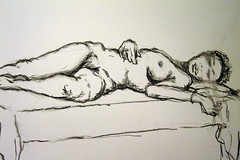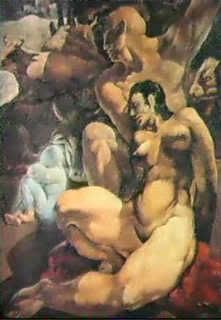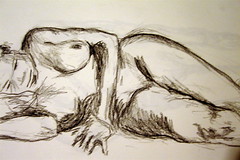Off Dancing With The Dead Folks

Hasta la vista, baby!
That which doesn't kill us merely postpones the inevitable.






Labels: poverty




















Stoltenberg presents a radical critique of the very concept "manhood," arguing that it serves no socially desirable function — only hurtful functions that can and should be eliminated from men's personal identities and social interactions. He presents a provocative alternative to most thinking about men and the problematic aspects of our behavior and identity. He bases his critiques on the claim that "manhood," in all of its various masculine incarnations, is at odds with, and in fact mutually exclusive of, an authentic sense of "selfhood" — a selfhood necessary for relating to others in just, moral, and non-violating ways...[A]uthor and lecturer John Stoltenberg addresses this question and a host of others with a bold passion, sense of humor, gift for story telling, and a deep commitment to what he calls "loving justice."
The neo-liberal economic policies—privatization, free trade, slashed social spending—that the Chicago School and the economist Milton Friedman have foisted on the world are catastrophic in two senses, argues this vigorous polemic. Because their results are disastrous—depressions, mass poverty, private corporations looting public wealth, by the author's accounting—their means must be cataclysmic, dependent on political upheavals and natural disasters as coercive pretexts for free-market reforms the public would normally reject. Journalist Klein (No Logo) chronicles decades of such disasters, including the Chicago School makeovers launched by South American coups; the corrupt sale of Russia's state economy to oligarchs following the collapse of the Soviet Union; the privatization of New Orleans's public schools after Katrina; and the seizure of wrecked fishing villages by resort developers after the Asian tsunami....[H]er critique hits home, as she demonstrates how free-market ideologues welcome, and provoke, the collapse of other people's economies. The result is a powerful populist indictment of economic orthodoxy.
"This is a book about making art. Ordinary art. Ordinary art means something like: all art not made by Mozart. After all, art is rarely made by Mozart-like people; essentially-statistically speaking-there aren't any people like that. Geniuses get made once-a-century or so, yet good art gets made all the time, so to equate the making of art with the workings of genius removes this intimately human activity to a strangely unreachable and unknowable place. For all practical purposes making art can be examined in great detail without ever getting entangled in the very remote problems of genius."
--from the Introduction
In this fascinating and eye-opening Revolution-era novel, Octavian, a black youth raised in a Boston household of radical philosophers, is given an excellent classical education. He and his mother, an African princess, are kept isolated on the estate, and only as he grows older does he realize that while he is well dressed and well fed, he is indeed a captive being used by his guardians as part of an experiment to determine the intellectual acuity of Africans. As the fortunes of the Novanglian College of Lucidity change, so do the nature and conduct of their experiments...The issues of slavery and human rights, racism, free will, the causes of war, and one person's struggle to define himself are just as relevant today.
Afghan-American novelist Hosseini follows up his bestselling The Kite Runner with another searing epic of Afghanistan in turmoil. The story covers three decades of anti-Soviet jihad, civil war and Taliban tyranny through the lives of two women. Mariam is the scorned illegitimate daughter of a wealthy businessman, forced at age 15 into marrying the 40-year-old Rasheed, who grows increasingly brutal as she fails to produce a child. Eighteen later, Rasheed takes another wife, 14-year-old Laila, a smart and spirited girl whose only other options, after her parents are killed by rocket fire, are prostitution or starvation. Against a backdrop of unending war, Mariam and Laila become allies in an asymmetrical battle with Rasheed, whose violent misogyny—"There was no cursing, no screaming, no pleading, no surprised yelps, only the systematic business of beating and being beaten"—is endorsed by custom and law. Hosseini gives a forceful but nuanced portrait of a patriarchal despotism where women are agonizingly dependent on fathers, husbands and especially sons, the bearing of male children being their sole path to social status. His tale is a powerful, harrowing depiction of Afghanistan, but also a lyrical evocation of the lives and enduring hopes of its resilient characters.
First published in 1950, The Labyrinth of Solitude addresses issues that are both seemingly eternal and resoundingly contemporary: the nature of political power in post-conquest Mexico, the relation of Native Americans to Europeans, the ubiquity of official corruption. Noting these matters earned Paz no small amount of trouble from the Mexican leadership, but it also brought him renown as a social critic. Paz, who went on to win the Nobel Prize for Literature, later voiced his disillusionment with all political systems--as the Mexican proverb has it, "all revolutions degenerate into governments"--but his call for democracy in this book has lately been reverberating throughout Mexico, making it timely once again.
Often, emotional abuse builds over a long period of time until it becomes so unbearable that victims lash out in frustration and anger, only to appear unstable and aggressive themselves. This, according to Hirigoyen, is the intent of many abusers: to systematically "destabilize" and confuse their victims (with irrational, threatening behavior that preys on the victim's fears and self-doubts), to isolate and control them and ultimately to destroy their identity. These relentless "predators" are also incapable of compassion or empathy, always blame the victim and never see their actions as wrong.
Tepper's finest novel to date is set in a post-holocaust feminist dystopia that offers only two political alternatives: a repressive polygamist sect that is slowly self-destructing through inbreeding and the matriarchal dictatorship called Women's Country. Here, in a desperate effort to prevent another world war, the women have segregated most men into closed military garrisons and have taken on themselves every other function of government, industry, agriculture, science and learning.
"Being a warrior has nothing to do with waging war. Being a warrior means you have the courage to know who you are. Warriors never give up on anyone, including themselves."-from Sacred World
The muralists' work took up the themes of society and revolution. Often the paintings depicted historical vignettes like the story of Cuernavaca and Morelos crossing the barranca, or Mexico's ancient Indians. They satirized contemporary society, created ideal visions of peaceful families, and built up dark, imposing industrial cityscapes then leveled them by depicting the debauchery and death of the capitalist industrialists. The paintings themselves reflect diverse artistic influences--surrealism, cubism, and illustration, most notable among them. Their bold colors and strong imagery practically bound out of the 150 color plates in this book.
"When my daughter was about seven years old, she asked me one day what I did at work. I told her I worked at the college--that my job was to teach people how to draw.
She stared back at me, incredulous, and said, 'You mean they forget?'" --Howard Ikemoto,
from Art & Fear by David Bayles & Ted Orland



"Ansel Adams, never one to mistake precision for perfection, often recalled the old adage that 'the perfect is the enemy of the good', his point being that if he waited for everything in the scene to be exactly right, he'd probably never make a photograph.
Adams was right: to require perfection is to invite paralysis. The pattern is predictable: as you see error in what you have done, you steer your work toward what you imagine you can do perfectly. You cling ever more tightly to what you already know you can do--away from risk and exploration, and possibly further from the work of your heart. You find reasons to procrastinate, since to not work is to not make mistakes. Believing that artwork should be perfect, you gradually become convinced that you cannot make such work. (You are correct.) Sooner or later, since you cannot do what you are trying to do, you quit. And in one of those perverse little ironies of life, only the pattern itself achieves perfection--a perfect death spiral: you misdirect your work; you stall; you quit."


"The seed for your next art work lies embedded in the imperfections of your current piece." --Bayles & Orland
"The ceramics teacher announced on opening day that he was dividing the class into two groups. All those on the left side of the studio, he said, would be graded solely on the quantity of work they produced, all those on the right solely on its quality. His procedure was simple: on the final day of class he would bring in his bathroom scales and weigh the work of the "quantity" group: fifty pounds of pots rated an "A", forty pounds a "B", and so on. Those being graded on "quality", however, needed to produce only one pot--albeit a perfect one--to get an "A".
Well, came grading time and a curious fact emerged: the works of highest quality were all produced by the group being graded for quantity. It seems that while the "quantity" group was busily churning out piles of work--and learning from their mistakes--the "quality" group had sat theorizing about perfection, and in the end had little more to show for their efforts than grandiose theories and a pile of dead clay."
-from Art & Fear: Observations On The Perils (And Rewards) of Artmaking, by David Bayles & Ted Orland
To: Parents of Monkeybutt
From: Granny of the Apes
Ok, here's my first list of potential boy names:
arthur
bonzo
cornelius
darwin
elijah
finster
george
ham
ishmael
julius
kikazaru
luke
mazaru
nikko
ojo
pepe
razzberry
spike
thelonius
ungawa
virgil
washoe
zephyr
What do these all have in common, you ask? Why, they're all names of FAMOUS MONKEYS, of course!
My first vote is for Zephyr, but I also really love Finster and Thelonius (especially if his nickname becomes "Monk").
Mucho de loove,
-Granny of the Apes
From: Father of Monkeybutt
To: Granny of the Apes
Attachments: Scans of Ultrasounds
Medical angst be damned... may I introduce MISTER Monkeybutt!
Sorry if the resolution isn't great, the originals aren't super clear and they lose a little something in the scanning process. Let me know if you can't find his foot or hand or whatever.
Much love,
Father of Monkeybutt
Image of Boyness
Monkeybutt with weird superfluous little image drifting on the right that they think looks like a goblin.
From: Granny of the Apes
To: Parents of Monkeybutt
ZOMG!!1! Monkeybutt is so BEAUTIFUL! I have never seen such a beautiful fetus, ever. He is simply perfect. It's too bad they can't do color ultrasounds yet, I want to see what color his fuzz is. Lanugo, is that what it's called? It's been such a long long time since I thought about prenatal stuff.
Oh I think that goblin thingie looks exactly like a Calavera de Azucar. Or no, wait, maybe it's a Grateful Deadhead decal. Oooo, maybe
you're going to have a baby hippie!! :-|
Tons of love!
-Granny of the Apes
To: Granny of the Apes
From: Mother of Monkeybutt
Now we have the fear of hippies deep in us. While we were looking at the ultrasound yesterday, we swear that we saw a peace sign. We started freaking out that it was going to come out smelling like patchouli with dreds or something. So now that you think it's going to be a hippie, we're really scared! And yes it does look like a calavera de azucar. Seriously.
Love,
Mother of Monkeybutt
To: Parents of Monkeybutt
From: Granny of the Apes
Oh boy! Don't get me started on hippie names
Doobie! Fillmore! Moonjava! Snowphish! Stoner!
No, wait, I've got it: REVOLUTION!!!! We can call him Revvie.
But, um, Dude??? No. As much as I love The Big Lebowski, NOT Dude. And why the hell isn't Che on there? Or Fidel? Seriously, I vote for Revolution
Garcia Boomer.
Damn, this makes ME want to go out and start having many new babies, just so I can give them all fabulous hippie names. Be VERY afraid.
xxxx,
Granny of the Apes